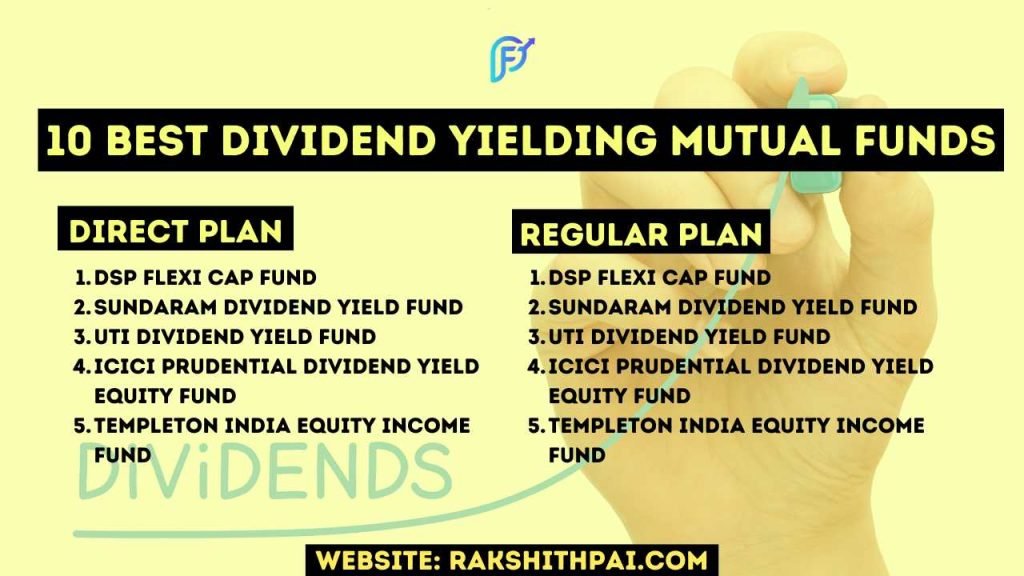Table of Contents
What are Dividend Yield Funds?
The primary focus of dividend yield funds, as a subset of mutual funds, is on investing in firms with the ability to pay dividends on a consistent basis. The Securities and Exchange Board of India (SEBI) requires that at least 65% of a dividend yield fund’s assets be invested in dividend-paying securities.
Dividend yield mutual funds are divided into two categories based on equity exposure. A dividend-paying equity fund has a minimum equity investment of 65%. Unless otherwise specified, the fund is dividend-paying equity or debt fund.
How Do Dividend-Paying Mutual Funds Work?
Mutual funds that pay dividends provide investors with annualized payments. As a result of the regularity of these distributions, you, as an investor, will feel secure and at ease with these funds. These dividends will be paid from the fund’s earnings from the previous year.
Mutual funds with a high dividend yield often put their money into the stocks of firms that pay out dividends on a consistent basis. Dividends are distributed to stockholders only when a company has a positive net income.
Mutual Funds (MF) with a dividend option do not exhibit a quick increase in net asset value (NAV) since dividends are paid out very immediately upon reaching a specified threshold. In the case of debt funds, fund houses are required to pay a Dividend Distribution Tax (DDT) of 28.84%, inclusive of cess and surcharge. In contrast, equity mutual funds do not incur a DDT.
The equities underpinning these mutual funds are, therefore, almost always those of firms with healthy bottom lines. But even the best dividend-paying mutual funds have some risk because their returns are affected by changes in the market.
Dividend mutual funds could be a good investment for people who don’t mind taking risks and want to get money every month.
15 Highest Dividend Paying Stocks in India 2023
Why Invest in Dividend Yield Funds?
A Dividend Yield Funds portfolio consists of stocks that have a track record for consistent dividend payout with improvements in dividend year after year. Hence such companies are chosen that are not only good dividend payers but also have the ability to pay dividends through the market cycle.
These are the companies that can now maintain a stable dividend payment schedule. Investors may profit from dividends by investing in a mutual fund with a high dividend yield.
Therefore, these are recommended for conservative individuals who want some exposure to the stock market. But even though underlying companies often have steady growth potential, this is rarely a good reason to expect a high return.
Features of Dividend Yield Funds:
The following are some of the features of Dividend Paying Mutual Funds;
Fund Manager
Dividend Investing is not just picking up the highest dividend-paying companies and investing for a long. There are a lot of factors involved if you wish to not lose your capital. Because an extremely high dividend-yielding investment could most likely affect your capital invested negatively. That’s why we need professional advice.
Fund managers of dividend yield mutual funds make portfolio adjustments based on data gleaned from intensive study and analysis, honed over many years of experience. Therefore, the success of a fund is tied to the quality of its management. An established fund manager has a better chance of helping a program reach its goal.
Direct or Regular
Direct plans are such mutual funds that are sold directly to investors without any intermediaries. There are no brokers or distributors involved in selling these investments. Because there are no middlemen, their reported NAV is higher and their expense ratio is lower than that of traditional plans.
Traditional plans or regular mutual funds are those you usually see being advertised in your brokerage accounts and other sources. These mutual funds, although perform the same, are a bit expensive because of all the marketing costs involved for them to reach you.
Fees & Charges
To Professionally manage your Dividend Yielding Portfolio, your fund manager charges a certain amount for the service. It’s called an expense ratio.
The term “expense ratio” is used to describe the percentage of an investor’s investment that is deducted each year to cover a fund’s operational and administrative costs. The NAV of a scheme, which is what ultimately determines returns, is affected by this fee.
Determine the best dividend yield mutual fund by comparing the expense ratio of several schemes and taking into account other important aspects.
Exit Charge
The term “exit load” describes the fee that investors must pay if they cash out their units before their term is up. The cost of participating in a mutual fund program varies widely. Before investing in a dividend-yielding mutual fund, individuals should research the exit load.
Maximize Your Mutual Fund Investing Returns:
Expectation
It’s obvious that we expect our dividend to cover our expenses. We expect dividend investing to be a way for us to earn the most needed passive income. But, superficial expectations are not suggested.
Every investor has a unique goal in mind when it comes to their portfolio. One investor’s goal may be long-term stability and a steady stream of income, while another’s goal may be a short-term gain. That’s why, before deciding how much of one’s savings to put into the top dividend-yielding mutual funds in 2022, one must first determine what that saving’s final goal is.
Risk Appetite
Investors have different levels of risk tolerance or risk appetite. A conservative investor, for instance, may want to avoid any choice that is very sensitive to fluctuations in the market. Therefore, before parting with one’s savings, one must take stock of one’s own risk profile.
Advantages of Dividend Yield Funds:
Passive Income
Dividends are one of the best forms of passive income. Some of the well-established companies grow their dividend payout as their earnings per share rise. Hence, a dividend investing in large companies will yield better returns than most debt securities or savings deposits.
10 Best Ways to Make Passive Income in India – 2022
Safety
Dividend Mutual Fund is mostly chosen by conservative investors who tend to prefer low-risk investments. Dividend-paying companies earn better revenues and are mostly net cash positive. Hence, these funds offer a safe alternative for low-risk takers.
Disadvantages of Dividend Yield Funds:
Capital Loss
Usually, high dividend-paying companies are the PSUs. Although PSU companies tend to give good dividends for a consistently longer duration, such a high dividend payout cost the companies in terms of further growth. Due to these reasons, dividend-paying companies do not perform well and their stock price does not move much.
Underperformers
Dividend-paying Mutual Funds do not perform as the other Growth and Value-based mutual funds do. Dividend Mutual funds concentrate on dividend-paying companies and thus compromise on growth investments. Hence, the return from mutual funds is moderate to low.
Tax Benefits on Dividend Yield Funds?
If the dividends you get from this form of mutual fund plan are more than Rs. 5,000, the government will withhold 10% of the total as Tax Deduction as Source (TDS).
Gains on the sale of units held for more than a year are subject to a 10% tax since they are considered long-term capital gains. However, long-term capital gains are subject to tax only after they surpass Rs. 1 lakh. Any profits under Rs. 1 lakh are exempt from tax.
And, Gains realized from the sale of an investment held for less than a year are subject to a short-term capital gains tax at a rate of 15%.
10 Best Dividend Yielding Mutual Funds:
Here are some of the best-performing Dividend Mutual Funds;

Five (5) Best Dividend Yielding Mutual Funds (Direct Plans)
| Sl. No | Scheme Name | AuM (Cr) | 1Y Return | 3Y Return | 5Y Return |
|---|---|---|---|---|---|
| 1 | DSP Flexi Cap Fund | 7,739.45 | -0.09% | 19.76% | 13.57% |
| 2 | Sundaram Dividend Yield Fund | 306.11 | 3.52% | 20.37% | 12.57% |
| 3 | UTI Dividend Yield Fund | 2,877.84 | -0.24% | 18.41% | 12.00% |
| 4 | ICICI Prudential Dividend Yield Equity Fund | 1,012.67 | 15.91% | 22.73% | 11.01% |
| 5 | Templeton India Equity Income Fund | 1,291.95 | 14.09% | 24.83% | 14.19% |
Five (5) Best Dividend Yielding Mutual Funds (Regular Plans)
| Sl. No | Scheme Name | AuM (Cr) | 1Y Return | 3Y Return | 5Y Return |
|---|---|---|---|---|---|
| 1 | DSP Flexi Cap Fund | 7,739.45 | -0.09% | 19.76% | 13.57% |
| 2 | Sundaram Dividend Yield Fund | 306.11 | 3.52% | 20.37% | 12.57% |
| 3 | UTI Dividend Yield Fund | 2,877.84 | -0.24% | 18.41% | 12.00% |
| 4 | ICICI Prudential Dividend Yield Equity Fund | 1,012.67 | 15.91% | 22.73% | 11.01% |
| 5 | Templeton India Equity Income Fund | 1,291.95 | 14.09% | 24.83% | 14.19% |
Dividend Reinvestment Plan: Everything You Need to Know
Conclusion:
When talking about stock mutual funds, “dividend mutual funds” are what is meant when the focus is on investing in companies that pay dividends. Financial gains made by a business that is distributed to its stockholders are known as dividends.
Companies like these are great options for those seeking equity exposure with less risk, as they tend to be more stable than the market as a whole. Dividend yield funds are a great investment for most people, but they aren’t a smart choice for those who are looking for rapid growth.
Disclaimer: All the information on this website is published in good faith and for general information purposes only.









